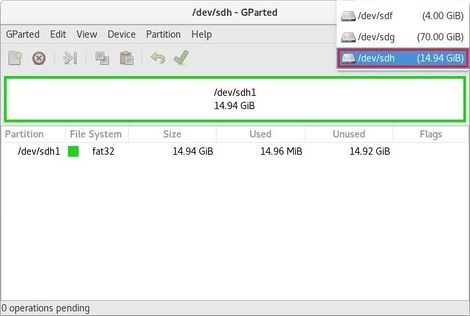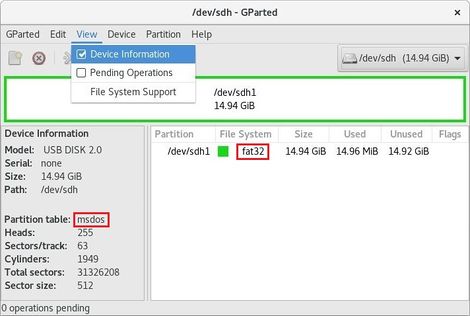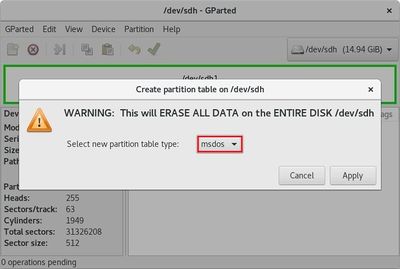DHCOM How to use the Update Mechanism: Difference between revisions
From Wiki-DB
Jump to navigationJump to search
Jneuhauser (talk | contribs) No edit summary |
Jneuhauser (talk | contribs) No edit summary |
||
| Line 25: | Line 25: | ||
* Choose your device in the drop down menu right at the top of the user interface | * Choose your device in the drop down menu right at the top of the user interface | ||
:[[File:Gparted_select_device.JPG|470px]] | :[[File:Gparted_select_device.JPG|470px]] | ||
: <span style="color: red;"> | : <span style="color: red;">Warning: Be sure that you have selected the correct device. The following steps will cause data loss on the selected device!</span> | ||
=== Check current partition table and partition format === | === Check current partition table and partition format === | ||
* Verify that you already have a DOS partition table and that the first partition is formatted as FAT32 by selecting Device Information in the View menu | * Verify that you already have a DOS partition table and that the first partition is formatted as FAT32 by selecting '''''Device Information''''' in the '''''View''''' menu | ||
:[[File:Gparted_show_device_info.JPG|470px]] | :[[File:Gparted_show_device_info.JPG|470px]] | ||
* If you see <span style="color: | * If you see <span style="color: orange;">Partition table: msdos</span> and <span style="color: orange;">File System: fat32</span> your USB stick is already prepared for the Update Mechanism and you can head over to [[#Place Update Files on the USB stick]] | ||
* If you only see <span style="color: orange;">Partition table: msdos</span> head over to [[#Create FAT32 formatted partition]] | |||
* And if you don´t see anything like in the picture follow the next steps | |||
=== Create DOS partition table | === Create DOS partition table === | ||
* Create empty dos partition table and | * Create a empty dos partition table with '''''Create Partition Table''''' in the '''''Device''''' menu and ensure you select <span style="color: orange;">msdos</span> as type. | ||
: <span style="color: | : <span style="color: red;">Warning: The following steps will cause data loss on the selected device!</span> | ||
:[[File: | :[[File:Gparted_create_partition_table.JPG|400px]] | ||
=== Create FAT32 formatted partition === | |||
= Place Update Files on the USB stick = | = Place Update Files on the USB stick = | ||
Revision as of 08:22, 23 October 2019
This guide describes how to properly update the built-in flash or eMMC memory on DHCOM devices with a provided update zip file.
Required hard- and software
- DHCOM Update files mostly provided as zip file (If you don't have the needed update files, please ask DH electronics)
- Windows / Linux computer or virtual machine with a administrative account
- Empty USB stick with at least 1 GB capacity
- DHCOM i.MX6 / i.MX25 / AM335x / AM35xx
- Baseboard with USB port like PDK2 / picoITX2 / DRC02
Prepare a USB stick or SD card for the update process
The bootloader update mechanism expects a single FAT32 partition on a storage device such as a USB stick or SD card.
Make the USB stick available in your system by connecting it to your computer. If you work with a virtual machine, then connect the newly connected USB stick to your virtual machine.
Linux (Debian)
This step by step guide has been developed and tested with the Virtual Machine for Application Development from DH electronics and should also work with gparted on other linux distros.
Prepare for the next steps
- Open the disk utility GParted
- Note: You will be asked for your user password to gain super user right through sudo.
- Choose your device in the drop down menu right at the top of the user interface
- Warning: Be sure that you have selected the correct device. The following steps will cause data loss on the selected device!
Check current partition table and partition format
- Verify that you already have a DOS partition table and that the first partition is formatted as FAT32 by selecting Device Information in the View menu
- If you see Partition table: msdos and File System: fat32 your USB stick is already prepared for the Update Mechanism and you can head over to #Place Update Files on the USB stick
- If you only see Partition table: msdos head over to #Create FAT32 formatted partition
- And if you don´t see anything like in the picture follow the next steps
Create DOS partition table
- Create a empty dos partition table with Create Partition Table in the Device menu and ensure you select msdos as type.


